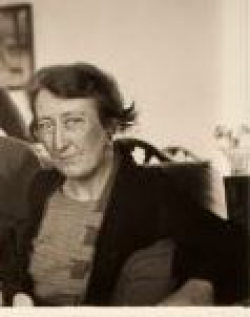Marjory Stephenson

Marjory Stephenson. Reproduced with permission from the archives of The Department of Biochemistry, University of Cambridge
- Born
- 24 January 1885
- Died
- 12 December 1948 (age 63)
Marjory Stephenson was one of the first women to be elected a Fellow of the Royal Society. Her work was one of the first examples of adaptive enzymes and her book, Bacterial Metabolism, became the standard textbook for generations of microbiologists.
Stephenson was born in 1885, the youngest child of a scientifically-minded fruit farmer. She was encouraged in her studies by both her parents, and benefited form a good education at Berkhamsted High School for Girls, where she could study science.
This enabled her to enrol at Newnham College at Cambridge University in 1903, to study natural sciences with courses in chemistry, physiology and zoology. This was at a time when the female students still wore long skirts, undertook practical classes separately from male students and were chaperoned to lectures outside the college.
Stephenson was keen to study medicine but did not have the funds to do so, and so in 1906 she became a domestic science teacher. However, she did not find this fulfilling and took up a post at University College London, where she lectured on the biochemistry of nutrition.
This work was interrupted by the First World War when Stephenson joined the Red Cross, where she ran kitchens in France. She later worked for the Voluntary Aid Detachment in Salonika. In 1918 she was awarded an MBE and an Associate Royal Red Cross. Her war experiences led to her becoming a pacifist.
After the war, Stephenson returned to Cambridge to work with Frederick Gowland Hopkins. Following his advice, she focussed her research on bacteria and their metabolism. She was working on annual grants, having no fixed job. She worked on fat soluble vitamins and developed this into more general studies on the biochemical activities of bacteria. She took an interdisciplinary approach, combining enzymology, physiology and evolutionary biology which was ground-breaking at the time.
Along with Margaret Whetham and Juda Quastel, she developed Louis Pasteur’s washed suspension technique, for extracting enzymes from bacteria. In 1928, working with Leonard Stickland, she was the first to isolate a bacterial enzyme, lactic dehydrogenase from Escherichia coli. This showed one of the first examples of an adaptive enzyme.
animated throughout by the imaginative insight which enabled her to consider the microbe, not as a useful device or as a pest to be eliminated, but as a living organism going about its own legitimate business
Dorothy Needham, on Stephenson’s book Bacterial Metabolism
In 1930, Stephenson wrote Bacterial Metabolism which became a standard textbook for generations of microbiologists. In 1945 she was one of two women to become the first to be elected as a Fellow to the Royal Society (the other was Kathleen Lonsdale). She was also a founder member of the Society for General Microbiology and became its President.



